Information Technology-Based Intervention on the Socio-Emotional Competence of Individuals with Autism Spectrum Disorders: A Systematic Review and Meta-Analysis
Abstract
1. Introduction
2. Methods
2.1. Registration
2.2. Search Strategy
2.3. Study Inclusion and Exclusion Criteria
3. Data Extraction
4. Quality Appraisal
5. Data Analysis and Synthesis
Social Validity
6. Results
6.1. Study Characteristics
6.2. Quality Appraisal Results
6.3. Meta-Analysis Results
6.3.1. Emotion Recognition
6.3.2. Emotion Understanding
6.3.3. Emotion Expression
6.3.4. Emotion Regulation
6.3.5. Heterogeneity
6.3.6. Publication Bias and Influence on Findings
6.3.7. Subgroup Analyses
7. Discussion
8. Conclusions
Supplementary Materials
Author Contributions
Funding
Institutional Review Board Statement
Informed Consent Statement
Data Availability Statement
Conflicts of Interest
References
- American Psychiatric Association, DSM-5 Task Force. 2013. Diagnostic and Statistical Manual of Mental Disorders: DSM-5™, 5th ed. Washington: American Psychiatric Association Publishing, Inc. [Google Scholar] [CrossRef]
- Bazoolnejad, Masoumeh, Samira Vakili, Manouchehr Moradi Sabzevar, Leila Kashani Vahid, and Sara Khoddam. 2022. The effectiveness of computer games on communication skills and emotion regulation of children with autism spectrum disorder. Journal of Fundamentals of Mental Health 24: 213–21. [Google Scholar]
- Beaumont, Renae, Hugh Walker, Jonathan Weiss, and Kate Sofronoff. 2021. Randomized Controlled Trial of a Video Gaming-Based Social Skills Program for Children on the Autism Spectrum. Journal of Autism and Developmental Disorders 51: 3637–50. [Google Scholar] [CrossRef]
- Bekele, Esubalew, Julie Crittendon, Zhi Zheng, Amy Swanson, Amy Weitlauf, Zachary Warren, and Nilanjan Sarkar. 2014. Assessing the utility of a virtual environment for enhancing facial affect recognition in adolescents with autism. Journal of Autism and Developmental Disorders 44: 1641–50. [Google Scholar] [CrossRef]
- Bruggink, Arjan, Sasja Huisman, Richard Vuijk, Vivian Kraaij, and Nadia Garnefski. 2015. Cognitive emotion regulation, anxiety and depression in adults with autism spectrum disorder. Research in Autism Spectrum Disorders 22: 34–44. [Google Scholar] [CrossRef]
- Capps, Lisa, Marian Sigman, and Nurit Yirmiya. 2009. Self-competence and emotional understanding in high-functioning children with autism. Development and Psychopathology 7: 137–49. [Google Scholar] [CrossRef]
- Cooper, Harris, Larry V. Hedges, and Jeffrey C. Valentine. 2019. The Handbook of Research Synthesis and Meta-Analysis. New York: Russell Sage Foundation. [Google Scholar]
- Didehbani, Nyaz, Tandra Allen, Michelle Kandalaft, Daniel Krawczyk, and Sandra Chapman. 2016. Virtual Reality Social Cognition Training for children with high functioning autism. Computers in Human Behavior 62: 703–11. [Google Scholar] [CrossRef]
- Fage, Charles, Charles Consel, Kattalin Etchegoyhen, Anouck Amestoy, Manuel Bouvard, Cécile Mazon, and Hélène Sauzéon. 2019. An emotion regulation app for school inclusion of children with ASD: Design principles and evaluation. Computers & Education 131: 1–21. [Google Scholar] [CrossRef]
- Fridenson-Hayo, Shimrit, Steve Berggren, Amandine Lassalle, Shahar Tal, Delia Pigat, Noga Meir-Goren, Helen O’Reilly, S. Ben-Zur, Sven Bölte, Simon Baron-Cohen, and et al. 2017. ‘Emotiplay’: A serious game for learning about emotions in children with autism: Results of a cross-cultural evaluation. European Child & Adolescent Psychiatry 26: 979–92. [Google Scholar] [CrossRef] [PubMed]
- Golan, Ofer, and Simon Baron-Cohen. 2006. Systemizing empathy: Teaching adults with Asperger syndrome or high-functioning autism to recognize complex emotions using interactive multimedia. Development and Psychopathology 18: 591–617. [Google Scholar] [CrossRef]
- Golan, Ofer, Emma Ashwin, Yael Granader, Suzy McClintock, Kate Day, Victoria Leggett, and Simon Baron-Cohen. 2010. Enhancing emotion recognition in children with autism spectrum conditions: An intervention using animated vehicles with real emotional faces. Journal of Autism and Developmental Disorders 40: 269–79. [Google Scholar] [CrossRef]
- Grynszpan, Ouriel, Patrice L. T. Weiss, Fernando Perez-Diaz, and Eynat Gal. 2013. Innovative technology-based interventions for autism spectrum disorders: A meta-analysis. Autism 18: 346–61. [Google Scholar] [CrossRef]
- Herrero, Jorge Fernández, and Gonzalo Lorenzo. 2020. An immersive virtual reality educational intervention on people with autism spectrum disorders (ASD) for the development of communication skills and problem solving. Education and Information Technologies 25: 1689–722. [Google Scholar] [CrossRef]
- Holeva, Vasiliki, Vasiliki-Aliki Nikopoulou, Chris Lytridis, Christos Bazinas, Petros Kechayas, George Sidiropoulos, Marianna Papadopoulou, Maria Dialechti Kerasidou, Charalambos Karatsioras, and Nikoleta Geronikola. 2024. Effectiveness of a robot-assisted psychological intervention for children with autism spectrum disorder. Journal of Autism and Developmental Disorders 54: 577–93. [Google Scholar] [CrossRef]
- Hopkins, Ingrid Maria, Michael W. Gower, Trista A. Perez, Dana S. Smith, Franklin R. Amthor, Casey Wimsatt, and Fred J. Biasini. 2011. Avatar assistant: Improving social skills in students with an ASD through a computer-based intervention. Journal of Autism and Developmental Disorders 41: 1543–55. [Google Scholar] [CrossRef]
- Huedo-Medina, Tania B., Julio Sanchez-Meca, Fulgencio Marin-Martinez, and Juan Botella. 2006. Assessing heterogeneity in meta-analysis: Q statistic or I2 index? Psychological methods 11: 193–206. [Google Scholar] [CrossRef] [PubMed]
- Hutton, Brian, Georgia Salanti, Deborah M. Caldwell, Anna Chaimani, Christopher H. Schmid, Chris Cameron, John P. Ioannidis, Sharon Straus, Kristian Thorlund, and Jeroen. P. Jansen. 2015. The PRISMA extension statement for reporting of systematic reviews incorporating network meta-analyses of health care interventions: Checklist and explanations. Annals of Internal Medicine 162: 777–84. [Google Scholar] [CrossRef]
- Ip, Horace H. S., Simpson W. L. Wong, Dorothy F. Y. Chan, Chen Li, Lo Lo Kon, Po Ke Ma, Kate S. Y. Lau, and Julia Byrne. 2022. Enhance affective expression and social reciprocity for children with autism spectrum disorder: Using virtual reality headsets at schools. Interactive Learning Environments 32: 1012–35. [Google Scholar] [CrossRef]
- Ip, Horace H. S., Simpson W. L. Wong, Dorothy F. Y. Chan, Julia Byrne, Chen Li, Vanessa S. N. Yuan, Kate S. Y. Lau, and Joe Y. W. Wong. 2016. Virtual reality enabled training for social adaptation in inclusive education settings for school-aged children with autism spectrum disorder (ASD). In Blended Learning: Aligning Theory with Practices, Paper presented at 9th International Conference, ICBL 2016, Beijing, China, 19–21 July 2016, Proceedings 9. Cham: Springer. [Google Scholar]
- Ip, Horace H. S., Simpson W. L. Wong, Dorothy F. Y. Chan, Julia Byrne, Chen Li, Vanessa S. N. Yuan, Kate S. Y. Lau, and Joe Y. W. Wong. 2018. Enhance emotional and social adaptation skills for children with autism spectrum disorder: A virtual reality enabled approach. Computers & Education 117: 1–15. [Google Scholar] [CrossRef]
- Kandalaft, Michelle R., Nyaz Didehbani, Daniel C. Krawczyk, Tandra T. Allen, and Sandra B. Chapman. 2013. Virtual reality social cognition training for young adults with high-functioning autism. Journal of Autism and Developmental Disorders 43: 34–44. [Google Scholar] [CrossRef]
- Kirst, Simone, Robert Diehm, Katharina Bögl, Sabine Wilde-Etzold, Christiane Bach, Michele Noterdaeme, Luise Poustka, Matthias Ziegler, and Isabel Dziobek. 2022. Fostering socio-emotional competencies in children on the autism spectrum using a parent-assisted serious game: A multicenter randomized controlled trial. Behaviour Research and Therapy 152: 104068. [Google Scholar] [CrossRef]
- Lievore, Rachele, Giulia Crisci, and Irene C. Mammarella. 2023. Emotion Recognition in Children and Adolescents with ASD and ADHD: A Systematic Review. Review Journal of Autism and Developmental Disorders. [Google Scholar] [CrossRef]
- Lin, Ling-Yi, Chang-Hsin Lin, Tsung-Yen Chuang, Sau Cheong Loh, and Shing Ying Chu. 2023. Using home-based augmented reality storybook training modules for facilitating emotional functioning and socialization of children with autism spectrum disorder. International Journal of Developmental Disabilities 71: 87–94. [Google Scholar] [CrossRef]
- Lorenzo, Gonzalo, Asunción Lledó, Jorge Pomares, and Rosabel Roig. 2016. Design and application of an immersive virtual reality system to enhance emotional skills for children with autism spectrum disorders. Computers & Education 98: 192–205. [Google Scholar] [CrossRef]
- Lyu, Chengchen, Hui Chen, Tong Xu, Xiaolan Peng, Faliang Huang, and Hongan Wang. 2023. DailyConnect: Piloting Interventions of Situation-Based Emotional Understanding in Naturalistic Home Settings for Children with Autism Spectrum Disorder. International Journal of Human-Computer Interaction 40: 4647–60. [Google Scholar] [CrossRef]
- Marino, Flavia, Paola Chilà, Stefania Trusso Sfrazzetto, Cristina Carrozza, Ilaria Crimi, Chiara Failla, Mario Busà, Giuseppe Bernava, Gennaro Tartarisco, David Vagni, and et al. 2019. Outcomes of a Robot-Assisted Social-Emotional Understanding Intervention for Young Children with Autism Spectrum Disorders. Journal of Autism and Developmental Disorders 50: 1973–87. [Google Scholar] [CrossRef]
- Modugumudi, Yogeswara Rao, Jayasree Santhosh, and Sneh Anand. 2013. Efficacy of Collaborative Virtual Environment Intervention Programs in Emotion Expression of Children with Autism. Journal of Medical Imaging and Health Informatics 3: 321–25. [Google Scholar] [CrossRef]
- Pouw, Lucinda B. C., Carolien Rieffe, Lex Stockmann, and Kenneth D. Gadow. 2013. The link between emotion regulation, social functioning, and depression in boys with ASD. Research in Autism Spectrum Disorders 7: 549–56. [Google Scholar] [CrossRef]
- Rashidan, Mohammad Ariff, Shahrul Na’im Sidek, Hazlina M. Yusof, Madihah Khalid, Ahmad Aidil Arafat Dzulkarnain, Aimi Shazwani Ghazali, Sarah Afiqah Mohd Zabidi, and Faizanah Abdul Alim Sidique. 2021. Technology-Assisted Emotion Recognition for Autism Spectrum Disorder (ASD) Children: A Systematic Literature Review. IEEE Access 9: 33638–53. [Google Scholar] [CrossRef]
- Reyes, Nuri M., Reina Factor, and Angela Scarpa. 2020. Emotion regulation, emotionality, and expression of emotions: A link between social skills, behavior, and emotion problems in children with ASD and their peers. Research in Developmental Disabilities 106: 103770. [Google Scholar] [CrossRef]
- Rice, Linda Marie, Carla Anne Wall, Adam Fogel, and Frederick Shic. 2015. Computer-Assisted Face Processing Instruction Improves Emotion Recognition, Mentalizing, and Social Skills in Students with ASD. Journal of Autism and Developmental Disorders 45: 2176–86. [Google Scholar] [CrossRef]
- Salvador, Michelle J., Sophia Silver, and Mohammad H. Mahoor. 2015. An emotion recognition comparative study of autistic and typically-developing children using the zeno robot. Paper presented at 2015 IEEE International Conference on Robotics and Automation (ICRA), Seattle, WA, USA, May 26–30. [Google Scholar]
- Serret, Sylvie, Stephanie Hun, Galina Iakimova, Jose Lozada, Margarita Anastassova, Andreia Santos, Stephanie Vesperini, and Florence Askenazy. 2014. Facing the challenge of teaching emotions to individuals with low- and high-functioning autism using a new Serious game: A pilot study. Molecular Autism 5: 37. [Google Scholar] [CrossRef]
- Sosnowski, David W., Cathleen O. Stough, Mary Jane Weiss, Tahra Cessna, Amy Casale, Adrienne Foran, Melanie Erwinski, John Wilson, Steven A. Farber, and Michael A. Farber. 2022. Brief report: A novel digital therapeutic that combines applied behavior analysis with gaze-contingent eye tracking to improve emotion recognition in children with autism spectrum disorder. Journal of Autism and Developmental Disorders 52: 2357–66. [Google Scholar] [CrossRef]
- Sterne, Jonathan A., Miguel A. Hernán, Barnaby C. Reeves, Jelena Savović, Nancy D. Berkman, Meera Viswanathan, David Henry, Douglas G. Altman, Mohammed T. Ansari, and Isabelle Boutron. 2016. ROBINS-I: A tool for assessing risk of bias in non-randomised studies of interventions. BMJ 355: i4919. [Google Scholar] [CrossRef] [PubMed]
- Tang, Julia S., Marita Falkmer, Nigel T. Chen, Sven Bölte, and Sonya Girdler. 2021. Development and feasibility of MindChip™: A social emotional telehealth intervention for autistic adults. Journal of Autism and Developmental Disorders 51: 1107–30. [Google Scholar] [CrossRef] [PubMed]
- Thomeer, Marcus L., Rachael A. Smith, Christopher Lopata, Martin A. Volker, Alanna M. Lipinski, Jonathan D. Rodgers, Christin A. McDonald, and Gloria K. Lee. 2015. Randomized Controlled Trial of Mind Reading and In Vivo Rehearsal for High-Functioning Children with ASD. Journal of Autism and Developmental Disorders 45: 2115–27. [Google Scholar] [CrossRef]
- Valentine, Althea Z., Beverley J. Brown, Madeleine J. Groom, Emma Young, Chris Hollis, and Charlotte L. Hall. 2020. A systematic review evaluating the implementation of technologies to assess, monitor and treat neurodevelopmental disorders: A map of the current evidence. Clinical Psychology Review 80: 101870. [Google Scholar] [CrossRef] [PubMed]
- Vasilevska Petrovska, Ivana, and Vladimir Trajkovski. 2019. Effects of a Computer-Based Intervention on Emotion Understanding in Children with Autism Spectrum Conditions. Journal of Autism and Developmental Disorders 49: 4244–55. [Google Scholar] [CrossRef] [PubMed]
- Weiss, Jonathan A., Kendra Thomson, Priscilla Burnham Riosa, Carly Albaum, Victoria Chan, Andrea Maughan, Paula Tablon, and Karen Black. 2018. A randomized waitlist-controlled trial of cognitive behavior therapy to improve emotion regulation in children with autism. Journal of Child Psychology and Psychiatry 59: 1180–91. [Google Scholar] [CrossRef]
- Williams, Beth T., Kylie M. Gray, and Bruce J. Tonge. 2012. Teaching emotion recognition skills to young children with autism: A randomised controlled trial of an emotion training programme. Journal of Child Psychology and Psychiatry 53: 1268–76. [Google Scholar] [CrossRef]
- Young, Robyn L., and Miriam Posselt. 2012. Using the transporters DVD as a learning tool for children with Autism Spectrum Disorders (ASD). Journal of Autism and Developmental Disorders 42: 984–91. [Google Scholar] [CrossRef]
- Yuan, Sze Ngar Vanessa, and Horace Ho Shing Ip. 2018. Using virtual reality to train emotional and social skills in children with autism spectrum disorder. London Journal of Primary Care 10: 110–12. [Google Scholar] [CrossRef] [PubMed]
- Zhi, Wang, Loh Sau Cheong, and Tian Jing. 2021. Meta-Analysis of Emotion Recognition Intervention Effects and Influencing Factors in Autism Spectrum Disorder. Education and Training in Autism and Developmental Disabilities 56: 479–93. [Google Scholar]
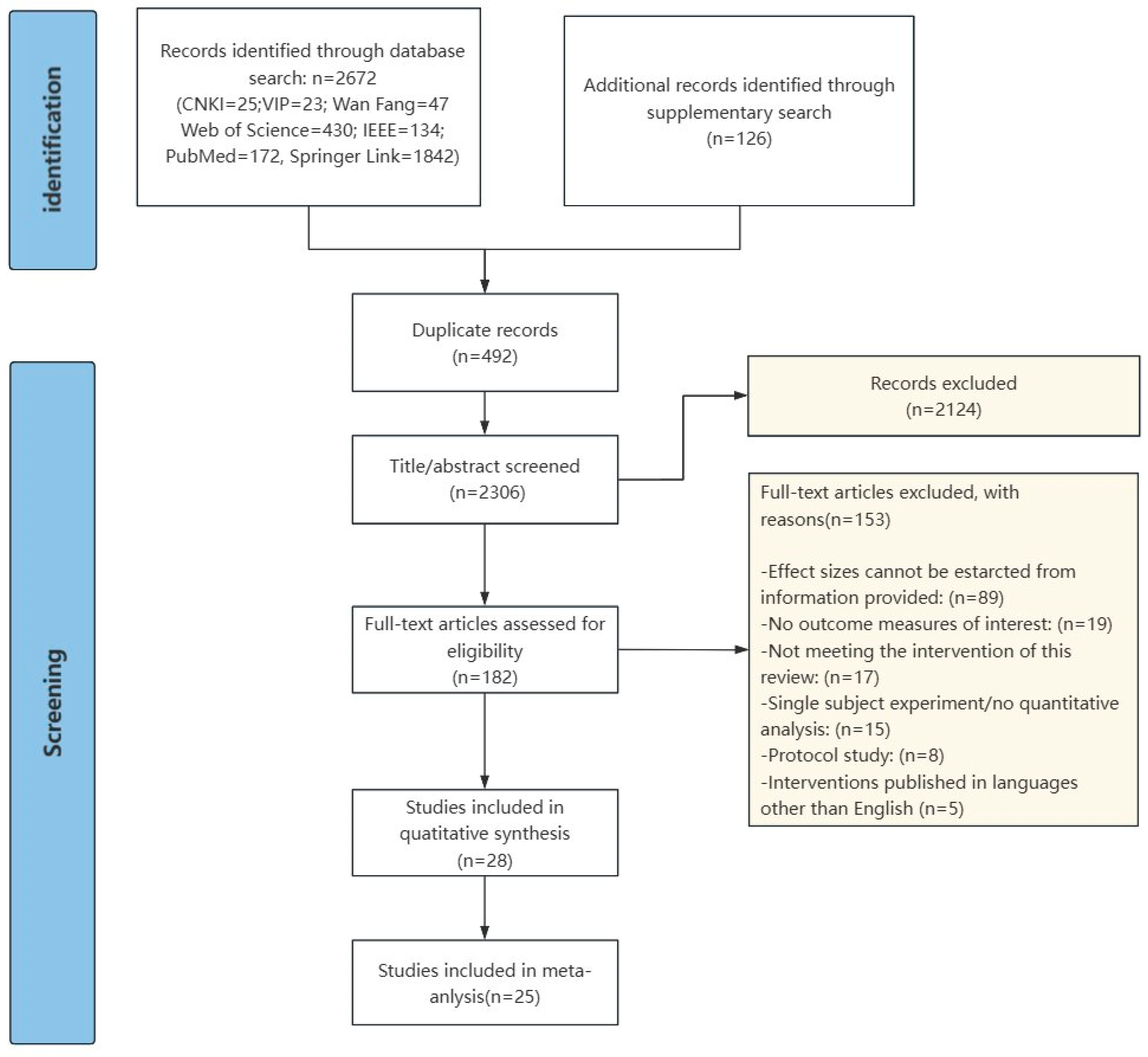
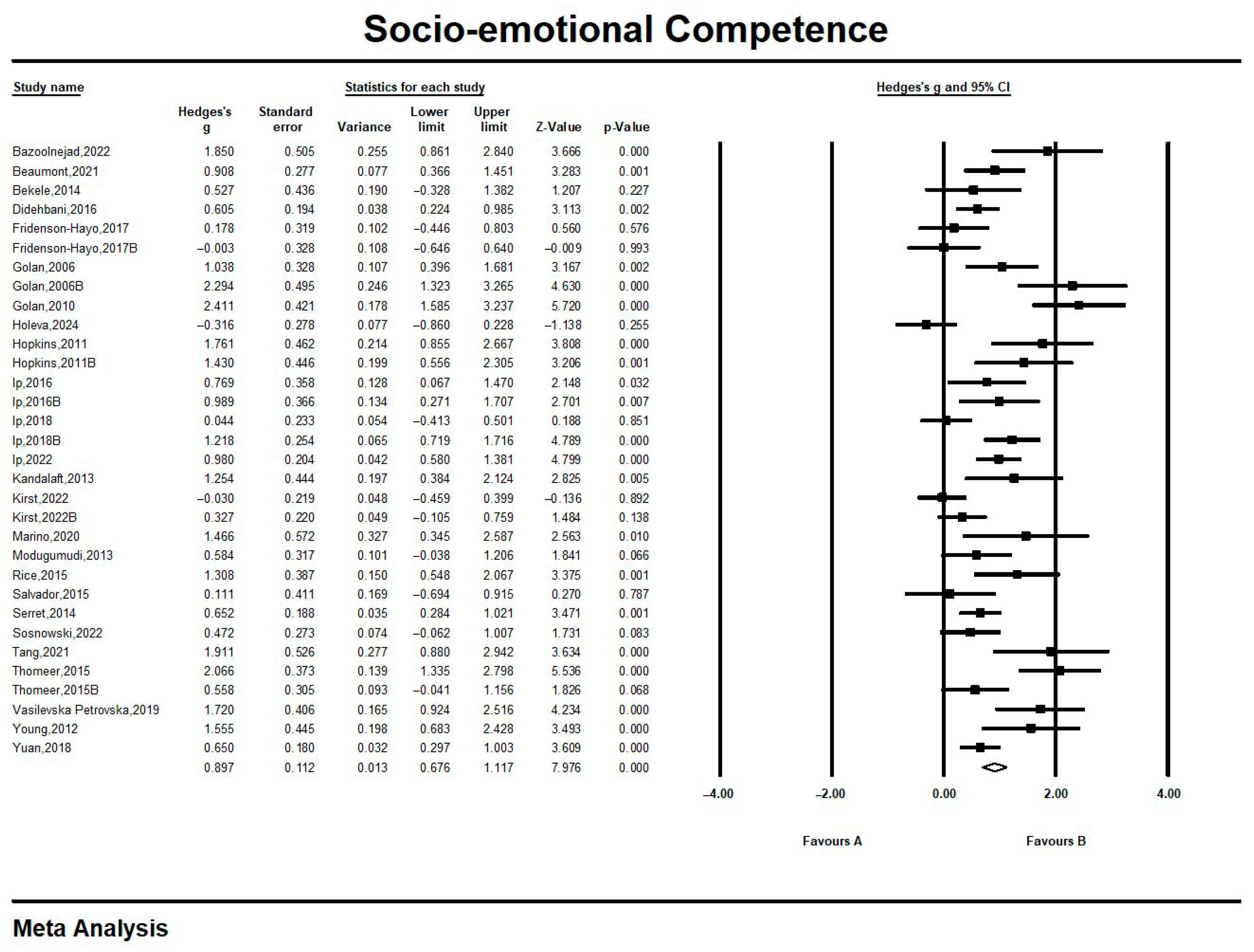
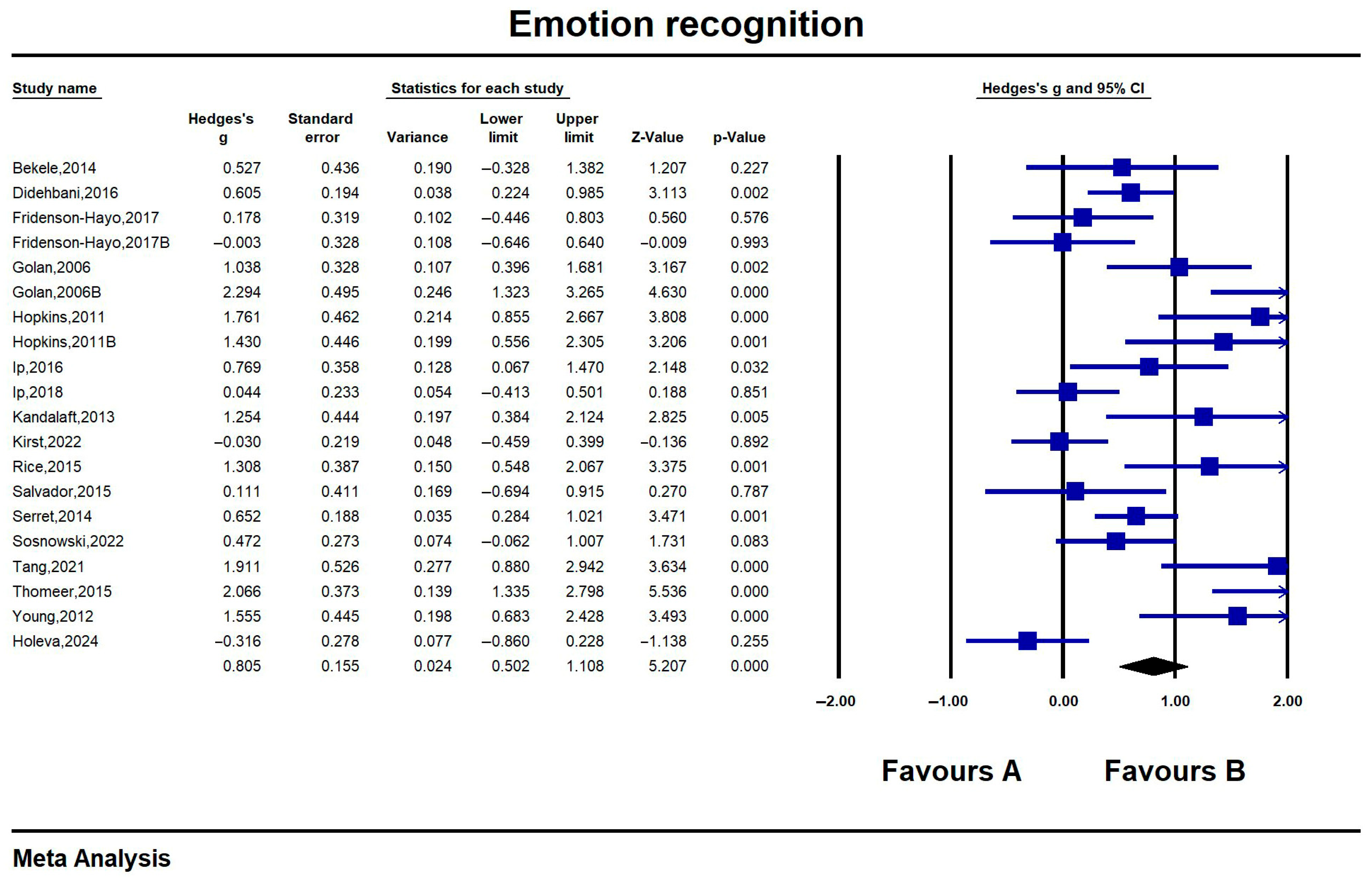
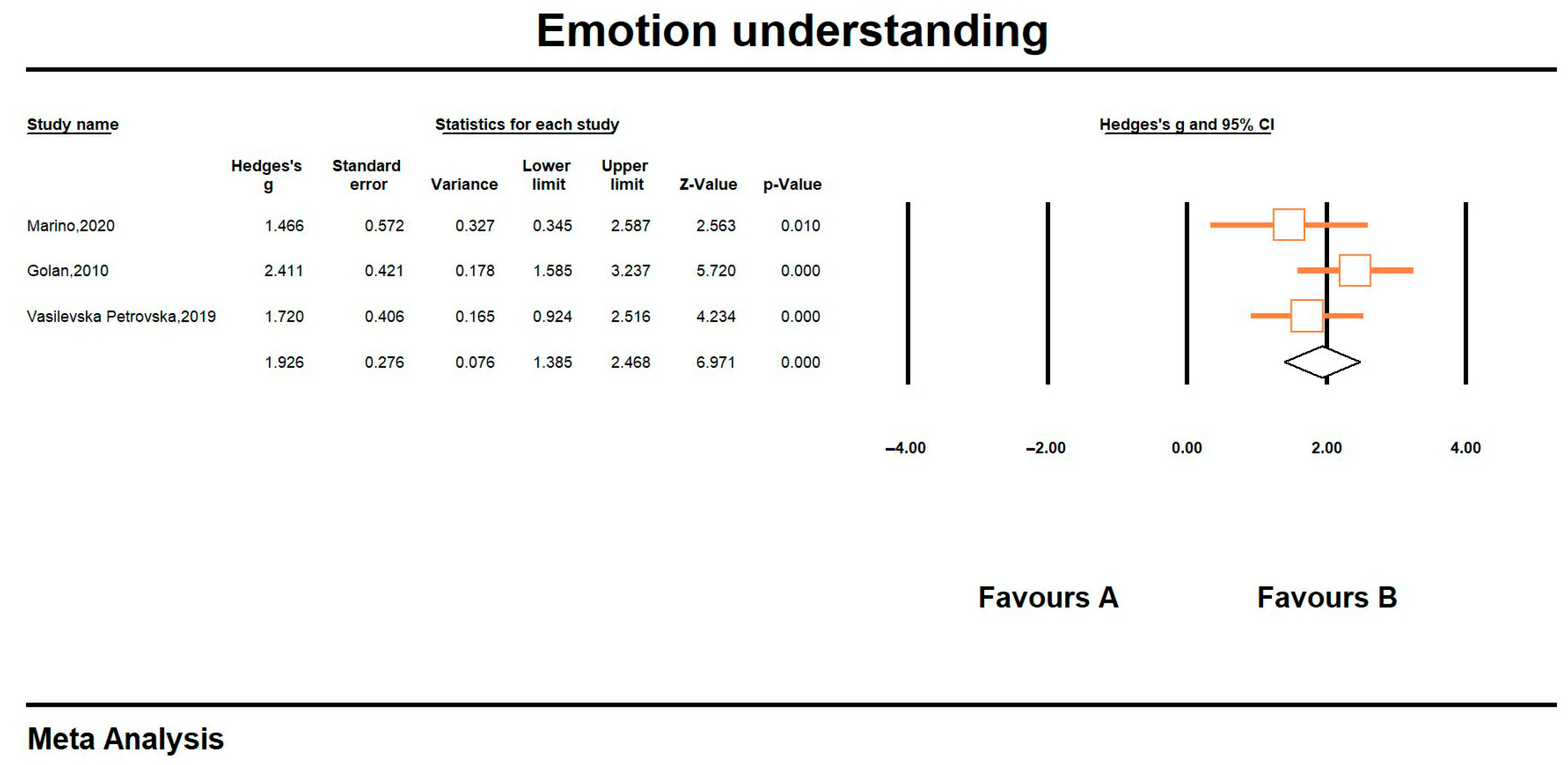
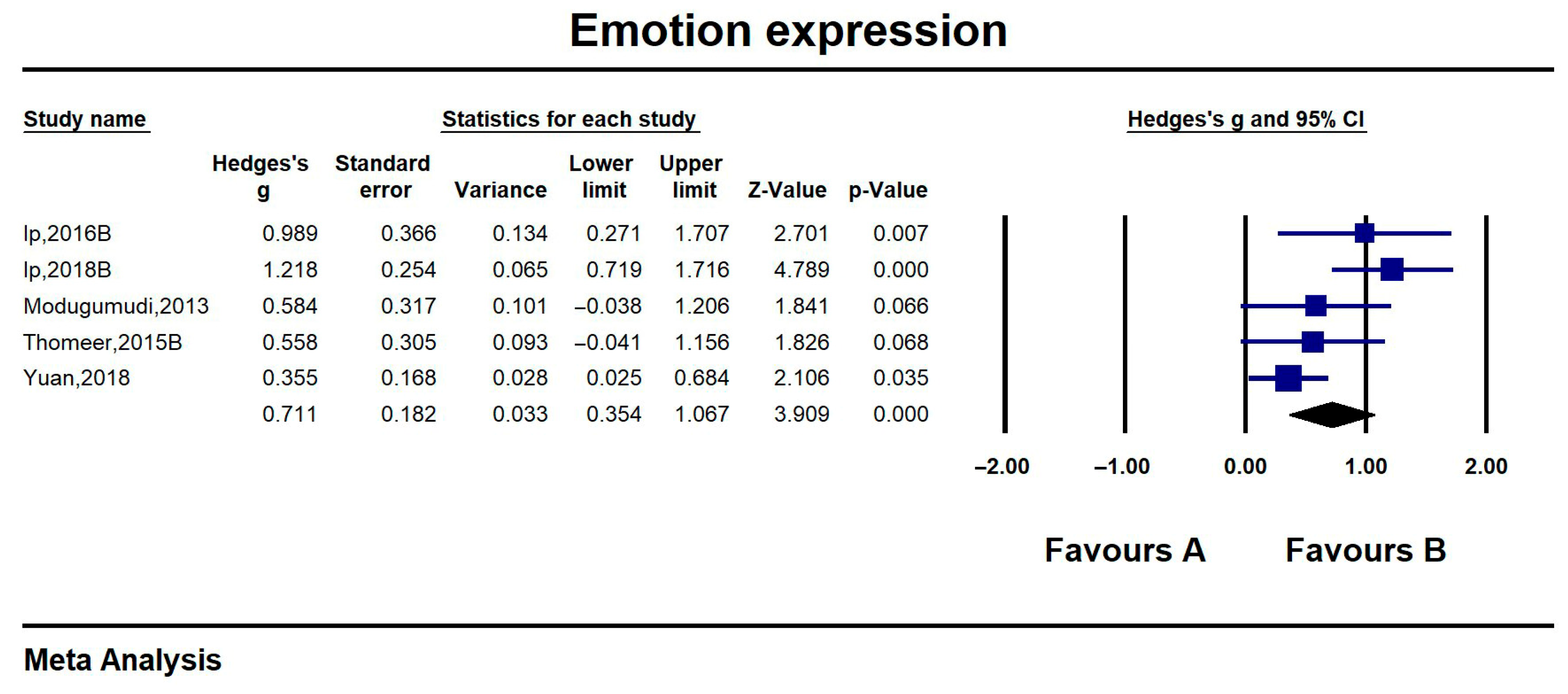
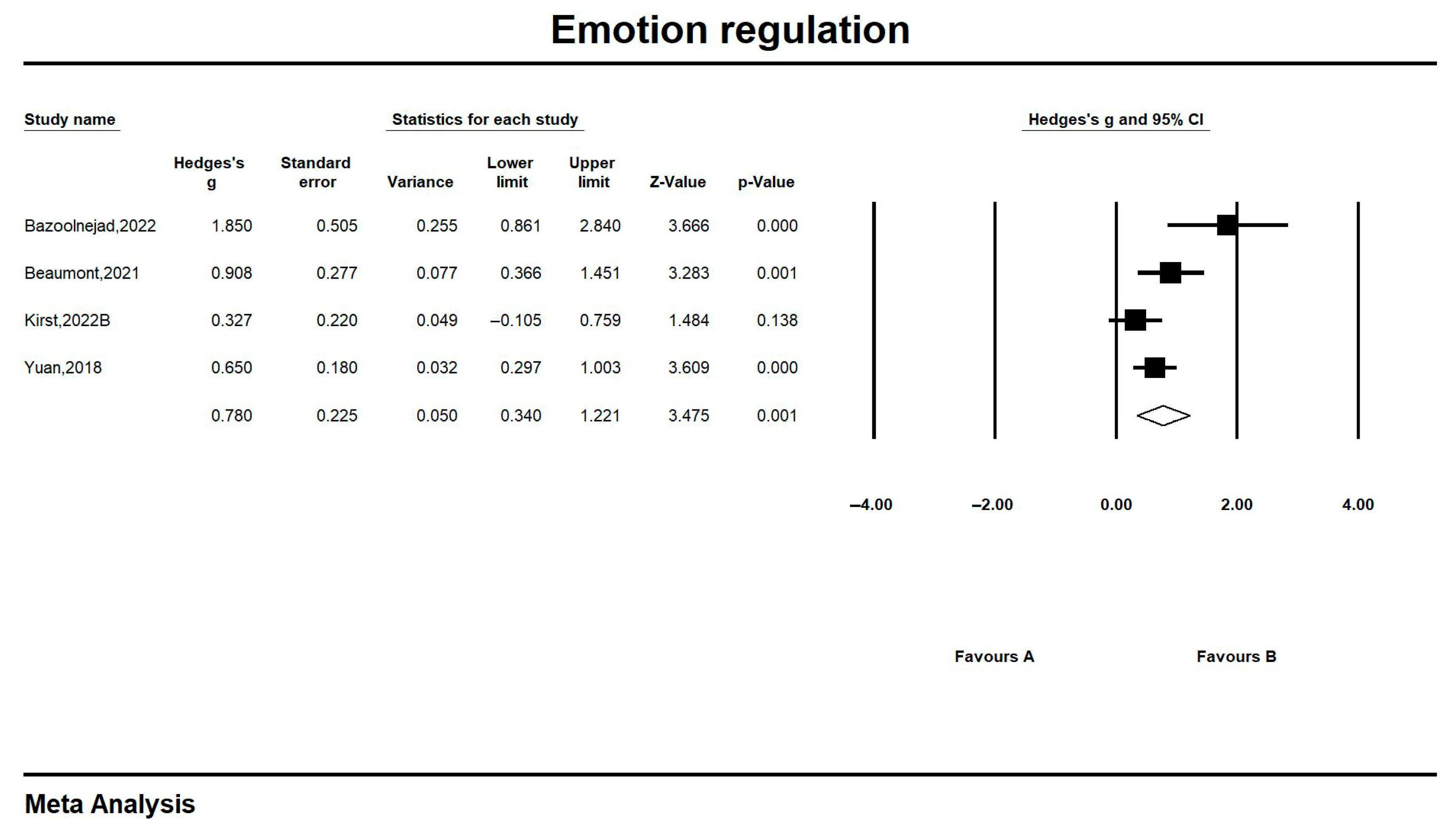
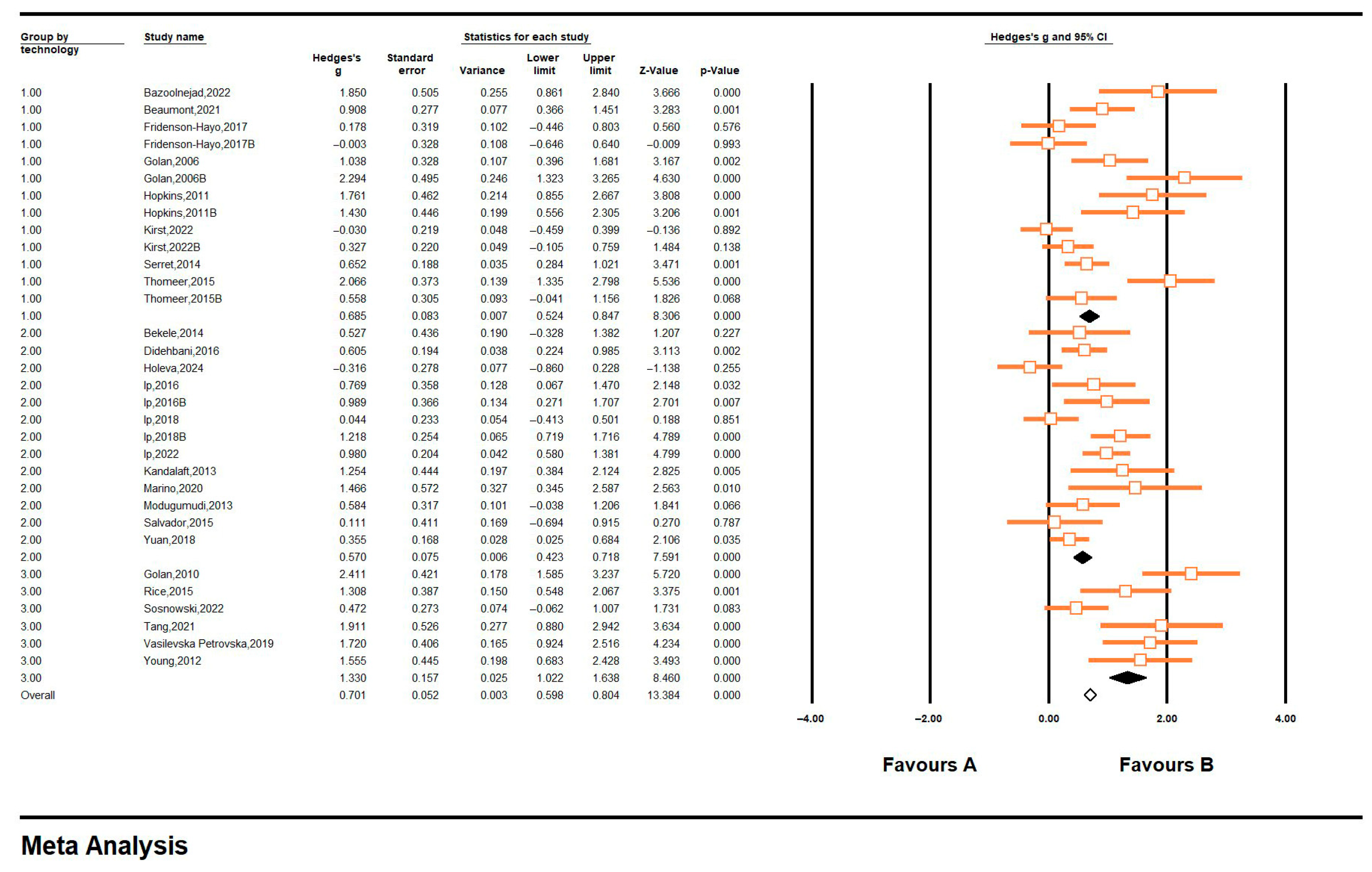
| Randomization Process | Deviations from Intended Interventions | Missing Outcome Data | Measurement of the Outcome | Selection of the Reported Result | Overall Bias | |
|---|---|---|---|---|---|---|
| Beaumont et al. (2021) | Low | Low | Low | Low | Low | Low |
| Bekele et al. (2014) | Low | Low | Low | Low | Low | Low |
| Fage et al. (2019) | NA | Some concerns | High | Low | Low | High |
| Fridenson-Hayo et al. (2017) | NA | Low | Low | Low | Low | Low |
| Fridenson-Hayo et al. (2017) | Low | Low | Low | Low | Low | Low |
| Golan and Baron-Cohen (2006) | Low | Low | Low | Low | Low | Low |
| Golan and Baron-Cohen (2006) | Low | Low | Low | Low | Low | Low |
| Golan et al. (2010) | Low | Some concerns | Low | Low | Low | Some concerns |
| Herrero and Lorenzo (2020) | Low | High | Some concerns | Low | Low | High |
| Holeva et al. (2024) | Low | Low | Low | Low | Low | Low |
| Hopkins et al. (2011) | Low | Low | Some concerns | Low | Low | Some concerns |
| Ip et al. (2016) | Low | Some concerns | Low | Low | Low | Some concerns |
| Ip et al. (2018) | Some concerns | Some concerns | Low | Low | Low | Some concerns |
| Ip et al. (2022) | Low | Low | Low | Low | Low | Low |
| Kirst et al. (2022) | Low | Some concerns | Low | Low | Low | Some concerns |
| Marino et al. (2019) | Low | Low | Low | Low | Low | Low |
| Modugumudi et al. (2013) | Some concerns | Some concerns | Low | Low | Low | Some concerns |
| Rice et al. (2015) | Low | Low | Low | Low | Low | Low |
| Salvador et al. (2015) | NA | Some concerns | Low | Low | Low | Some concerns |
| Sosnowski et al. (2022) | Low | Low | Low | Low | Low | Low |
| Tang et al. (2021) | Low | Some concerns | Low | Low | Low | Some concerns |
| Thomeer et al. (2015) | Low | Some concerns | Low | Some concerns | Low | Some concerns |
| Vasilevska Petrovska and Trajkovski (2019) | Low | Low | Low | Low | Low | Low |
| Young and Posselt (2012) | Low | Low | Low | Low | Low | Low |
| Yuan and Ip (2018) | Some concerns | Some concerns | Low | Low | Low | Some concerns |
| Study ID | Pre-Intervention | At Intervention | Post-Intervention | Overall Bias | ||||
|---|---|---|---|---|---|---|---|---|
| Bias Due to Confounding | Bias in Selection of Participants into the Study | Bias in Classification of Interventions | Bias Due to Deviations from Intended Interventions | Bias Due to Missing Data | Bias in Measurement of Outcomes | Bias in Selection of the Reported Result | ||
| Didehbani et al. (2016) | Low | Low | Low | NA | Low | Low | Low | Low |
| Kandalaft et al. (2013) | Low | Low | Low | Low | Low | Moderate | Low | Moderate |
| Lin et al. (2023) | Serious | Low | Low | Low | Low | Low | Low | Serious |
| Serret et al. (2014) | Moderate | Low | Low | Low | Low | Low | Low | Moderate |
| Bazoolnejad et al. (2022) | Low | Low | Low | Low | Low | Low | Low | Low |
Disclaimer/Publisher’s Note: The statements, opinions and data contained in all publications are solely those of the individual author(s) and contributor(s) and not of MDPI and/or the editor(s). MDPI and/or the editor(s) disclaim responsibility for any injury to people or property resulting from any ideas, methods, instructions or products referred to in the content. |
© 2025 by the authors. Licensee MDPI, Basel, Switzerland. This article is an open access article distributed under the terms and conditions of the Creative Commons Attribution (CC BY) license (https://creativecommons.org/licenses/by/4.0/).
Share and Cite
Liu, Y.; Li, S.; Huang, Y.; Li, D. Information Technology-Based Intervention on the Socio-Emotional Competence of Individuals with Autism Spectrum Disorders: A Systematic Review and Meta-Analysis. J. Intell. 2025, 13, 98. https://doi.org/10.3390/jintelligence13080098
Liu Y, Li S, Huang Y, Li D. Information Technology-Based Intervention on the Socio-Emotional Competence of Individuals with Autism Spectrum Disorders: A Systematic Review and Meta-Analysis. Journal of Intelligence. 2025; 13(8):98. https://doi.org/10.3390/jintelligence13080098
Chicago/Turabian StyleLiu, Yunshan, Sirao Li, Yaping Huang, and Dan Li. 2025. "Information Technology-Based Intervention on the Socio-Emotional Competence of Individuals with Autism Spectrum Disorders: A Systematic Review and Meta-Analysis" Journal of Intelligence 13, no. 8: 98. https://doi.org/10.3390/jintelligence13080098
APA StyleLiu, Y., Li, S., Huang, Y., & Li, D. (2025). Information Technology-Based Intervention on the Socio-Emotional Competence of Individuals with Autism Spectrum Disorders: A Systematic Review and Meta-Analysis. Journal of Intelligence, 13(8), 98. https://doi.org/10.3390/jintelligence13080098




